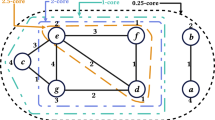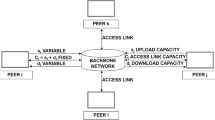Abstract
With innovations in the Internet, it is becoming increasingly relied upon. In the last decade, research on peer-to-peer (P2P) technology has become even more popular. As more people use P2P systems, the scalability and flexibility of the systems must be considered. In this study, an arrangement graph is used to form a P2P overlay, the Arrangement-Graph Overlay (AGO), to reduce system overhead and bind routing hops. The proposed AGO utilizes the properties of the arrangement graph, i.e., that each node has a unique ID and IDs between adjacent nodes differ by only one digit, to form the overlay network and develop a routing algorithm. The routing hops of the proposed AGO system can be bound within a certain number because of the diameter of the arrangement graph. Experimental results show that the proposed AGO system can greatly reduce system overhead and perform routing in a constant number of hops, even in a large-scale network environment. The experimental results also show that the AGO system consumes less bandwidth, which is an important consideration in P2P systems.












Similar content being viewed by others
References
Baumgart I, Heep B, Krause S (2007) OverSim: a flexible overlay network simulation framework. In: The proceedings of 10th IEEE global internet symposium (GI ’07) in conjunction with IEEE INFOCOM 2007. Anchorage, pp 79–84, doi:10.1109/GI.2007.4301435
Baumgart I, Heep B, Krause S (2009) OverSim: a scalable and flexible overlay framework for simulation and real network applications. In: The proceedings of IEEE ninth international conference on peer-to-peer computing (P2P’09). Seattle, pp 87–88
Chiang W-K, Chen R-J (1998) On the arrangement graph. J Inf Process Lett 66(4):215–219
Chen Y-S, Juang T-Y, Shen Y-Y (2000) Multi-node broadcasting in an arrangement graph using multiple spanning trees. In: The proceedings of the seventh international conference on parallel and distributed systems, pp 213–220
Day K, Tripathi A (1992) Arrangement graphs: a class of generalized star graphs. Inf Process Lett 42:235–241
Day K, Tripathi A (1993) Embedding of cycles in arrangement graphs. J IEEE Trans Comput 42(8):1002–1006
Day K, Tripathi A (1993) Embedding grids, hypercubes, and trees in arrangement graphs. In: The proceedings of international conference on parallel proceeding (ICPP 1993), vol 3. USA, pp 65–72
Heep B (2010) R/Kademlia: Recursive and topology-aware overlay routing. In: The proceedings of australasian telecommunication networks and applications conference, pp 102–107
Hsieh S-y, Chen G-H, Ho C-W (1997) Fault-tolerant ring embedding in faulty arrangement graphs. In: The proceedings of international conference on parallel and distributed systems. Seoul, pp 744–749
Haribabu K, Reddy D, Hota C, Yla-Jaaski A, Tarkoma S (2008) Adaptive lookup for unstructured peer-to-peer overlays. In: The proceedings of 3rd international conference on communication systems software and middleware and workshops 2008 (COMSWARE 2008). Bangalore, pp 776–782
Jiang S, Guo L, Zhang X (2003) LightFlood: an efficient flooding scheme for file search in unstructured peer-to-peer systems. In: The proceedings of the 2003 international conference on parallel processing (ICPP 2003). Kaohsiung, pp 627–635
Jiang S, Guo L, Zhang X (2008) LightFlood: minimizing redundant messages and maximizing scope of peer-to-peer search. J IEEE Trans Parallel Distrib Syst (TPDS) 19(5):601–614
Kobayasi M, Nakayama H, Ansari N, Kato N (2007) NHAG: network-aware hierarchical arrangement graph for application layer multicast in heterogeneous networks. In: The proceedings of 2007 global telecommunications conference (GLOBECOM ’07), pp 1993–1997
Kobayashi M, Nakayama H, Ansari N, Kato N (2009) Robust and efficient stream delivery for application layer multicasting in heterogeneous networks. J IEEE Trans Multimedia 1(1):166–176
Lua EK, Crowcroft J, Pias M, Sharma R, Lim S (2005) A survey and comparison of peer-to-peer overlay network schemes. J IEEE Commun Surv Tutor 7(2):72–93
Lu S-H, Lai K-C, Yang D-L, Li K-C, Chung Y-C (2010) Pervasive health service system: insights on the development of a Grid-based personal health service system. In: Proceedings of the 12th international conference on e-health networking, application and services (Healthcom2010). Lyon, pp 61–67
Maymounkov P, Mazieres D (2002) Kademlia: a peer-to-peer information system based on the XOR metric. In: The proceedings of the first international workshop on peer-to-peer systems. USA, pp 53–65
Munoz-Gea JP, Malgosa-Sanahuja J, Manzanares-Lopez P, Sanchez-Aarnoutse JC, Martinez-Rojo AM (2009) Simulation of a P2P application using OverSim. In: The proceedings of the first international conference on advances in future internet (AFIN 2009). Athens, pp 53–60
Rowstron A, Druschel P (2001) Pastry: scalable, distributed object location and routing for large-scale peer-to-peer systems. In: The proceedings of the IFIP/ACM international conference on distributed systems platforms Heidelberg (Middleware 2001), lecture notes in computer science, vol 2218/2001, pp 329–350
Ratnasamy S, Francis P, Handley M, Karp R, Shenker S (2001) A scalable content addressable network. In: The proceedings of conference on applications, technologies, architectures, and protocols for computer communications (ACM SIGCOMM 2001), pp 161–172
Stoica I, Morris R, Karger D, Frans Kaashoek M, Balakrishnan H (2001) Chord: A scalable peerto-peer lookup service for internet applications. In the proceedings of the 2001 conference on applications, technologies, architectures, and protocols for computer communications, pp 149–160. San Diego
Stoica I, Morris R, Liben-Nowell D, Karger D, Frans Kaashoek M, Dabek F, Balakrishnan H (2003) Chord: a scalable peer-to-peer lookup service for internet applications. J IEEE/ACM Trans Netw 11(1):17–32
Tian R, Zhang Q, Xiang Z, Xiong Y, Li X, Zhu W (2005) Robust and efficient path diversity in application-layer multicast for video streaming. J IEEE Trans Circ Syst Video Technol 15(8):961–972
The OverSim P2P Simulator - http://www.oversim.org/
Weibull distribution - http://en.wikipedia.org/wiki/Weibull_distribution
OMNeT++ Network Simulation Framework - http://www.omnetpp.org
Author information
Authors and Affiliations
Corresponding author
Rights and permissions
About this article
Cite this article
Lu, SH., Li, KC., Lai, KC. et al. A scalable P2P overlay based on arrangement graph with minimized overhead. Peer-to-Peer Netw. Appl. 7, 497–510 (2014). https://doi.org/10.1007/s12083-013-0229-z
Received:
Accepted:
Published:
Issue Date:
DOI: https://doi.org/10.1007/s12083-013-0229-z




